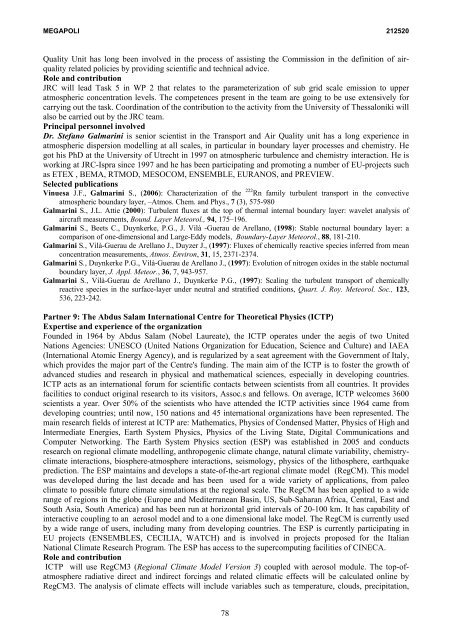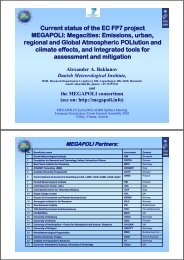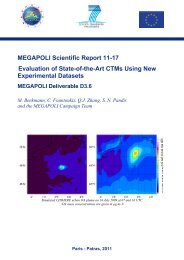D E S C R I P T I O N O F W O R K - MEGAPOLI - Dmi
D E S C R I P T I O N O F W O R K - MEGAPOLI - Dmi
D E S C R I P T I O N O F W O R K - MEGAPOLI - Dmi
Create successful ePaper yourself
Turn your PDF publications into a flip-book with our unique Google optimized e-Paper software.
<strong>MEGAPOLI</strong> 212520<br />
Quality Unit has long been involved in the process of assisting the Commission in the definition of airquality<br />
related policies by providing scientific and technical advice.<br />
Role and contribution<br />
JRC will lead Task 5 in WP 2 that relates to the parameterization of sub grid scale emission to upper<br />
atmospheric concentration levels. The competences present in the team are going to be use extensively for<br />
carrying out the task. Coordination of the contribution to the activity from the University of Thessaloniki will<br />
also be carried out by the JRC team.<br />
Principal personnel involved<br />
Dr. Stefano Galmarini is senior scientist in the Transport and Air Quality unit has a long experience in<br />
atmospheric dispersion modelling at all scales, in particular in boundary layer processes and chemistry. He<br />
got his PhD at the University of Utrecht in 1997 on atmospheric turbulence and chemistry interaction. He is<br />
working at JRC-Ispra since 1997 and he has been participating and promoting a number of EU-projects such<br />
as ETEX , BEMA, RTMOD, MESOCOM, ENSEMBLE, EURANOS, and PREVIEW.<br />
Selected publications<br />
Vinuesa J.F., Galmarini S., (2006): Characterization of the 222 Rn family turbulent transport in the convective<br />
atmospheric boundary layer, –Atmos. Chem. and Phys., 7 (3), 575-980<br />
Galmarini S., J.L. Attie (2000): Turbulent fluxes at the top of thermal internal boundary layer: wavelet analysis of<br />
aircraft measurements, Bound. Layer Meteorol., 94, 175–196.<br />
Galmarini S., Beets C., Duynkerke, P.G., J. Vilà -Guerau de Arellano, (1998): Stable nocturnal boundary layer: a<br />
comparison of one-dimensional and Large-Eddy models, Boundary-Layer Meteorol., 88, 181-210.<br />
Galmarini S., Vilà-Guerau de Arellano J., Duyzer J., (1997): Fluxes of chemically reactive species inferred from mean<br />
concentration measurements, Atmos. Environ, 31, 15, 2371-2374.<br />
Galmarini S., Duynkerke P.G., Vilà-Guerau de Arellano J., (1997): Evolution of nitrogen oxides in the stable nocturnal<br />
boundary layer, J. Appl. Meteor., 36, 7, 943-957.<br />
Galmarini S., Vilà-Guerau de Arellano J., Duynkerke P.G., (1997): Scaling the turbulent transport of chemically<br />
reactive species in the surface-layer under neutral and stratified conditions, Quart. J. Roy. Meteorol. Soc., 123,<br />
536, 223-242.<br />
Partner 9: The Abdus Salam International Centre for Theoretical Physics (ICTP)<br />
Expertise and experience of the organization<br />
Founded in 1964 by Abdus Salam (Nobel Laureate), the ICTP operates under the aegis of two United<br />
Nations Agencies: UNESCO (United Nations Organization for Education, Science and Culture) and IAEA<br />
(International Atomic Energy Agency), and is regularized by a seat agreement with the Government of Italy,<br />
which provides the major part of the Centre's funding. The main aim of the ICTP is to foster the growth of<br />
advanced studies and research in physical and mathematical sciences, especially in developing countries.<br />
ICTP acts as an international forum for scientific contacts between scientists from all countries. It provides<br />
facilities to conduct original research to its visitors, Assoc.s and fellows. On average, ICTP welcomes 3600<br />
scientists a year. Over 50% of the scientists who have attended the ICTP activities since 1964 came from<br />
developing countries; until now, 150 nations and 45 international organizations have been represented. The<br />
main research fields of interest at ICTP are: Mathematics, Physics of Condensed Matter, Physics of High and<br />
Intermediate Energies, Earth System Physics, Physics of the Living State, Digital Communications and<br />
Computer Networking. The Earth System Physics section (ESP) was established in 2005 and conducts<br />
research on regional climate modelling, anthropogenic climate change, natural climate variability, chemistryclimate<br />
interactions, biosphere-atmosphere interactions, seismology, physics of the lithosphere, earthquake<br />
prediction. The ESP maintains and develops a state-of-the-art regional climate model (RegCM). This model<br />
was developed during the last decade and has been used for a wide variety of applications, from paleo<br />
climate to possible future climate simulations at the regional scale. The RegCM has been applied to a wide<br />
range of regions in the globe (Europe and Mediterranean Basin, US, Sub-Saharan Africa, Central, East and<br />
South Asia, South America) and has been run at horizontal grid intervals of 20-100 km. It has capability of<br />
interactive coupling to an aerosol model and to a one dimensional lake model. The RegCM is currently used<br />
by a wide range of users, including many from developing countries. The ESP is currently participating in<br />
EU projects (ENSEMBLES, CECILIA, WATCH) and is involved in projects proposed for the Italian<br />
National Climate Research Program. The ESP has access to the supercomputing facilities of CINECA.<br />
Role and contribution<br />
ICTP will use RegCM3 (Regional Climate Model Version 3) coupled with aerosol module. The top-ofatmosphere<br />
radiative direct and indirect forcings and related climatic effects will be calculated online by<br />
RegCM3. The analysis of climate effects will include variables such as temperature, clouds, precipitation,<br />
78




